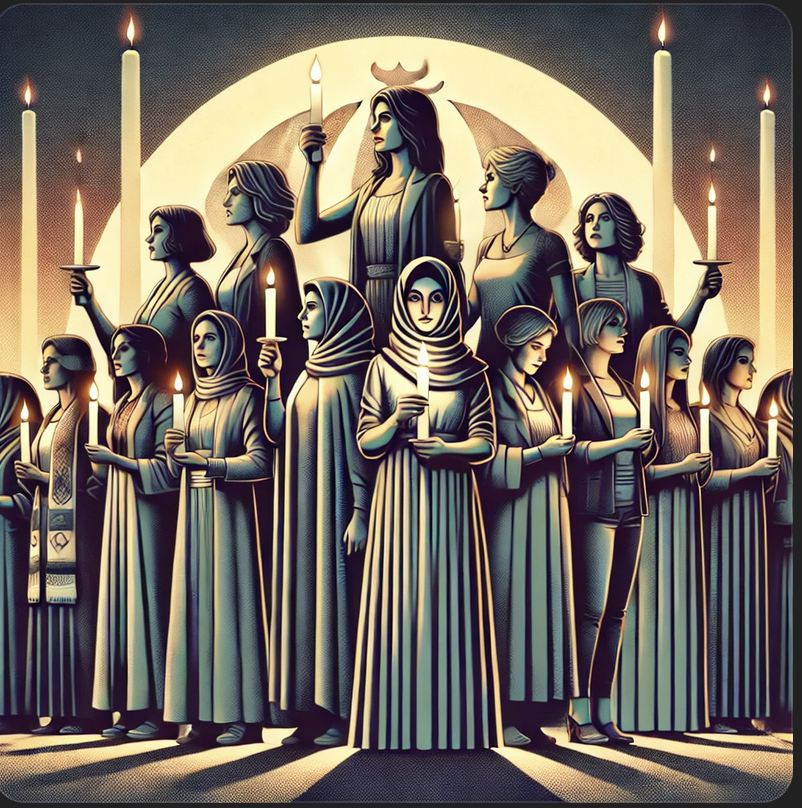

By Dr. Tim Orr
Mahsa Amini, also known as Jina Amini, was a 22-year-old Kurdish-Iranian woman whose life and tragic death have become emblematic of the struggle for women's rights and personal freedoms in Iran. Born on September 20, 1999, in Saqqez, Kurdistan Province, Amini was known for her kindness, vibrancy, and deep connection to her Kurdish heritage. Her friends and family described her as someone who navigated the complexities of life in Iran with a quiet strength and a hopeful spirit. Despite the systemic restrictions imposed on women, she managed to express herself within the boundaries set by the regime.
On September 13, 2022, while visiting Tehran with her family, Mahsa was arrested by the "Gasht-e Ershad," or morality police, for allegedly violating Iran's dress code for women, which mandates the wearing of a hijab. According to eyewitnesses present at the scene, she was roughly handled and taken away despite her brother's pleas. "I begged them to let her go, but they refused," her brother Kiarash later recounted to local media. The details of what happened after her arrest are murky, but reports indicate that she was severely beaten while in custody, leading to her falling into a coma. Her family and human rights organizations have since called for accountability, stating that Mahsa had no pre-existing medical conditions that could explain her sudden collapse. Amnesty International has condemned her death, stating that "the circumstances point to an arbitrary deprivation of life."
Why Did the Mullahs Do What They Did?
The crackdown on Mahsa Amini and countless others like her is rooted in the ideological framework of Iran's ruling clergy. The mullahs, who hold significant power in Iran, adhere to a strict interpretation of Islamic law that seeks to regulate not just religious life but the everyday conduct of individuals. This includes a particular focus on the role and appearance of women in society. The enforcement of hijab laws and other gender-specific regulations serves multiple purposes for the regime. Firstly, it acts as a means of exerting control over the population, reinforcing the idea that the government has the divine right to dictate personal behavior. Secondly, it perpetuates the notion of an ideal Islamic society where women's modesty is a marker of the community's collective morality.
Iran's morality police were established in 2005, and their presence has been a source of fear and anxiety for many women. According to a report by Human Rights Watch, thousands of women are detained or fined each year for violating dress codes. These regulations are not only a matter of religious observance but also a tool for the regime to assert its authority over women. The Iranian government justifies these laws as essential for maintaining social order and protecting Islamic values, but critics argue that they suppress individual freedoms. This approach is part of a broader strategy to control public morality and reinforce the state's power over its citizens.
Inside the Detention Center: The Events That Led to Her Death
While the specifics of what happened inside the detention center are still under investigation, multiple sources suggest that Mahsa Amini was subjected to severe physical violence. Eyewitnesses and reports from those who were present at the center indicate that Mahsa was beaten, particularly on her head. However, it is important to note that the Iranian regime has denied these allegations, claiming that Mahsa suffered from pre-existing health conditions—a claim her family vehemently disputes. The lack of transparency and the regime's history of suppressing dissent makes it challenging to verify the exact details of her treatment. Human rights organizations have called for an independent investigation, with Amnesty International urging the international community to press Iran for accountability.
Mahsa was taken to Kasra Hospital in a coma. Medical reports, later leaked, suggested that she had suffered a severe brain injury. According to a nurse who spoke to the media on condition of anonymity, Mahsa had bruises on her face and body, signs consistent with physical assault. Despite the regime’s attempt to present her death as a medical issue, the evidence points to a pattern of abuse that aligns with the testimonies of many others who the morality police have detained. This lack of accountability and the secrecy surrounding such incidents highlight the regime’s efforts to maintain a facade of compliance with human rights while continuing its oppressive practices.
Broader Historical Context: Women's Rights in Iran
The treatment of women in Iran has evolved over the past century, influenced by changing political regimes and interpretations of Islamic law. Before the 1979 Islamic Revolution, Iran underwent rapid modernization under the Pahlavi dynasty. Reza Shah Pahlavi's efforts in the early 20th century to modernize the country included the controversial Kashf-e hijab decree, which banned wearing the hijab in public as part of his broader push for secularism. This top-down approach, while intended to liberate women, was met with resistance from more conservative segments of society and was seen as an imposition of Western values.
In the 1960s and 70s, the White Revolution led by Mohammad Reza Shah further expanded women's rights, granting them the right to vote and increasing their participation in education and the workforce. However, these changes were accompanied by growing discontent among traditionalists who felt that the reforms were eroding Iran's Islamic and cultural identity. The Islamic Revolution 1979, led by Ayatollah Khomeini, marked a significant turning point. It brought about the establishment of an Islamic Republic and a strict interpretation of Sharia law that significantly rolled back women's rights. The regime introduced compulsory hijab laws and enforced strict codes of conduct, reasserting traditional gender roles and using Islamic principles to justify the control of women’s bodies and behavior.
Exploring the Ideological Basis: The Role of Wilayat al-Faqih
Wilayat al-Faqih (A concept I covered in my last blog), or "Guardianship of the Jurist," is at the core of Iran's theocratic system. This doctrine, established by Ayatollah Khomeini, grants the Supreme Leader and the religious establishment ultimate authority over the state, including the interpretation and enforcement of Islamic law. Under this system, the state is mandated to create a society that aligns with its interpretation of Islamic principles. This includes regulating women's behavior to ensure it conforms to the regime's vision of modesty and morality.
The Iranian regime views the hijab as a crucial aspect of Islamic identity and societal order. Women’s bodies are seen as both a source of moral corruption and a barometer of the community’s adherence to Islamic values. Therefore, controlling how women dress and behave is perceived as essential to maintaining the moral fabric of society. The morality police, as enforcers of these norms, are empowered to act with significant authority and little oversight. Critics argue that this focus on women's bodies is not rooted in religious necessity but in the regime's desire to assert control and reinforce its power. By making the hijab a visible marker of compliance, the regime uses it to symbolize the submission of the populace to its authority.
The Aftermath and Public Reaction
News of Mahsa Amini's death rapidly spread across Iran, leading to widespread public outcry. Her family, rejecting the state's claims about her medical condition, publicly called for an investigation. "She was healthy and had no health problems that could have led to such a collapse," her father stated in an interview with BBC Persian. Protests erupted not just in Tehran but across the country, with women burning their hijabs and cutting their hair in public as acts of defiance against the regime's compulsory dress code. The slogan "Woman, Life, Freedom" became a rallying cry, symbolizing the desire for basic human rights and autonomy.
The Iranian government responded to these protests with a brutal crackdown, using tear gas, batons, and live ammunition against demonstrators. According to a report by the Center for Human Rights in Iran, hundreds of people were arrested, and several were killed during the protests. Despite this, the movement sparked by Mahsa's death grew, gaining international attention and support. Human rights organizations worldwide have condemned the Iranian government's actions and called for the immediate release of those detained. The European Union and the United Nations have also called for an independent investigation into Mahsa Amini's death and the broader issue of women's rights in Iran.
Potential Solutions and Future Outlook
Mahsa Amini's death and the subsequent protests have brought renewed attention to the issue of women's rights in Iran and the regime's authoritarian practices. Activists are calling for fundamental changes, including the abolition of the morality police and the repeal of compulsory hijab laws. These demands go beyond dress codes to encompass broader human rights and personal freedoms. However, the regime's response so far suggests a reluctance to make concessions that would undermine its control over society. The Iranian government's crackdown on protests and censorship of dissenting voices highlight the challenges faced by activists pushing for change.
International pressure can play a role in supporting the movement for women's rights in Iran. Human rights organizations and foreign governments can continue to hold the Iranian regime accountable through diplomatic channels, sanctions, and advocacy. However, meaningful change will likely require a sustained domestic effort to challenge the ideological basis of the regime's control over women's lives. This includes encouraging a more inclusive interpretation of Islamic teachings that respects individual rights and freedoms. The ongoing protests and the global outcry suggest that the fight for women's rights in Iran is far from over, and Mahsa Amini's legacy continues to inspire those who seek a future free from oppression.
Conclusion
Mahsa Amini's life and death have become a powerful symbol of resistance against Iran's oppressive regime and its treatment of women. Her story has drawn international attention to the broader struggle for human rights in Iran and the systemic nature of the regime's efforts to control women's bodies and behavior. While her death has sparked a movement that demands change, it also highlights the challenges faced by those who seek to challenge the ideological and political foundations of the Iranian state. The fight for justice and equality in Iran continues, and Mahsa Amini's legacy reminds us of the courage and resilience of those who stand against oppression.
The ideas in this article are mine, but AI assisted in writing it.
Tim Orr is an Evangelical minister, conference speaker, and interfaith consultant with over 30 years of experience in cross-cultural ministry. He holds six degrees, including a master’s in Islamic studies from the Islamic College in London. Tim taught Religious Studies for 15 years at Indiana University Columbus and is now a Congregations and Polarization Project research associate. He has spoken at universities, including Oxford, and mosques throughout the U.K. His research focuses on American Evangelicalism, Islamic antisemitism, and Islamic feminism, and he has published widely, including three books.
 YouTube
YouTube
Sign up for Dr. Tim Orr's Blog
Dr. Tim Orr isn't just your average academic—he's a passionate advocate for interreligious dialogue, a seasoned academic, and an ordained Evangelical minister with a unique vision.
No spam. Unsubscribe anytime.
